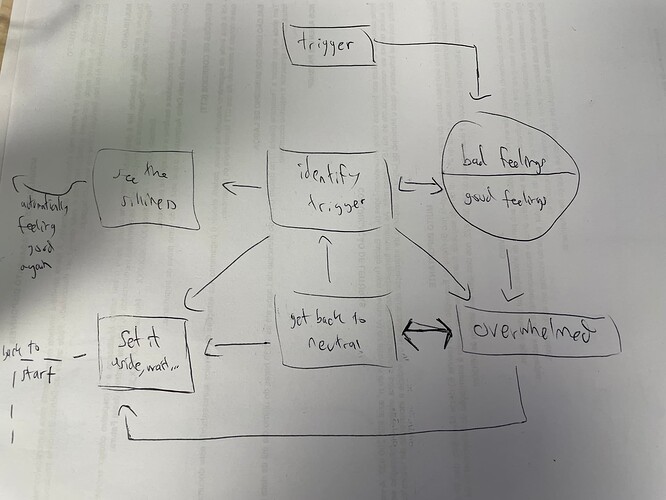Haha yes this is pretty tricky but also quite fun and hopefully useful by the end. I think what I will do is make a few different permutations of the diagram based on the suggestions and post them all on here, then it might be easier to have a poll on which one seems the most effective.
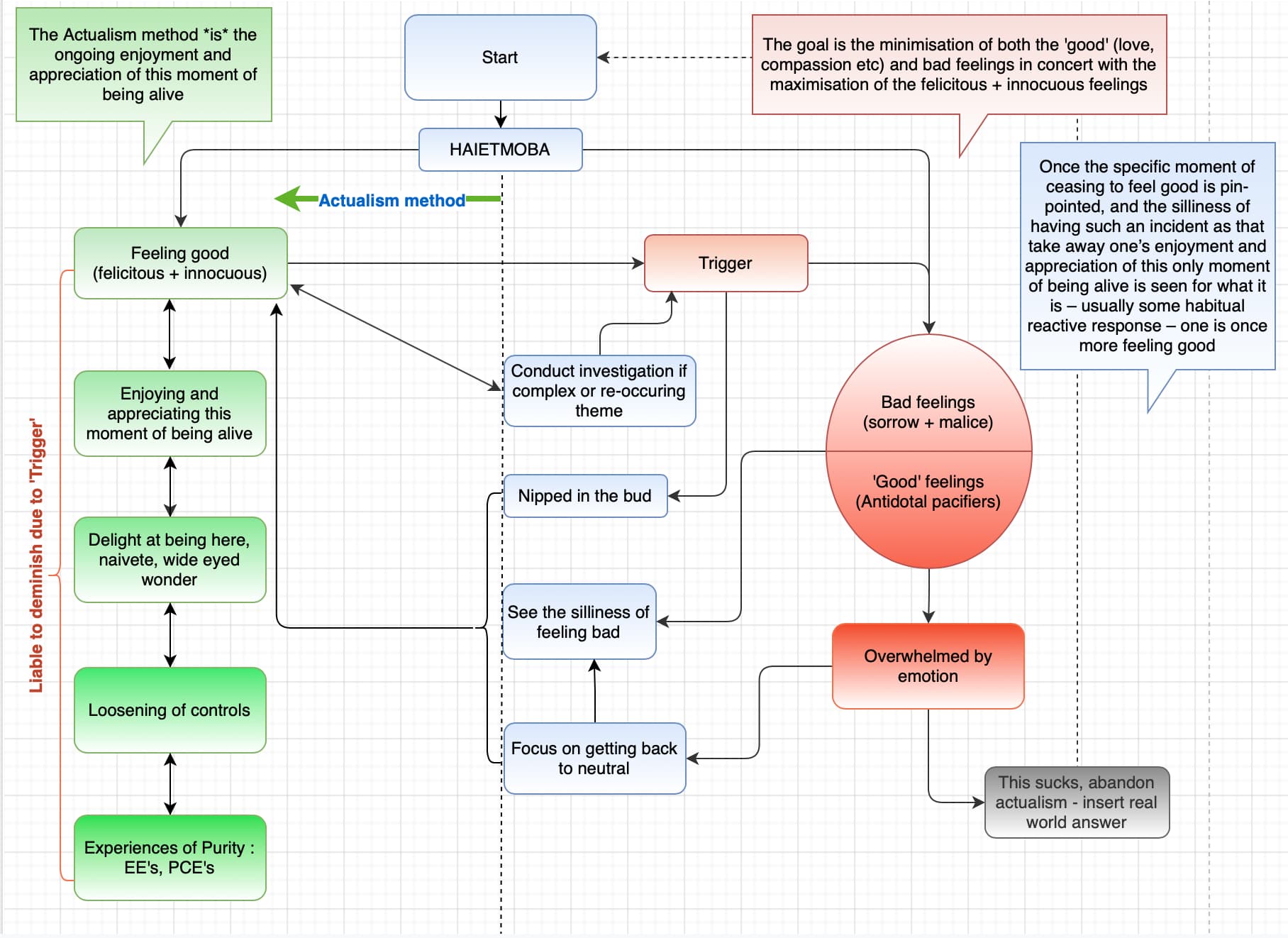
OK so I have done 3 different versions, this is the 1st and simplest one, I think personally it is also my favourite one, mostly because of the simplicity :
-
I have added the blue text box which explains the basics of how one sees the silliness of feeling bad and it also explains about finding the trigger
-
I have linked feeling neutral back into seeing the silliness for an extra step
-
The rest I have left as before with the intent of keeping the diagram somewhat simple and open to interpretation. All the tools and main pathways are on there and now it is up to the individual to make their way through with the knowledge they can gain through all the different sources available online.
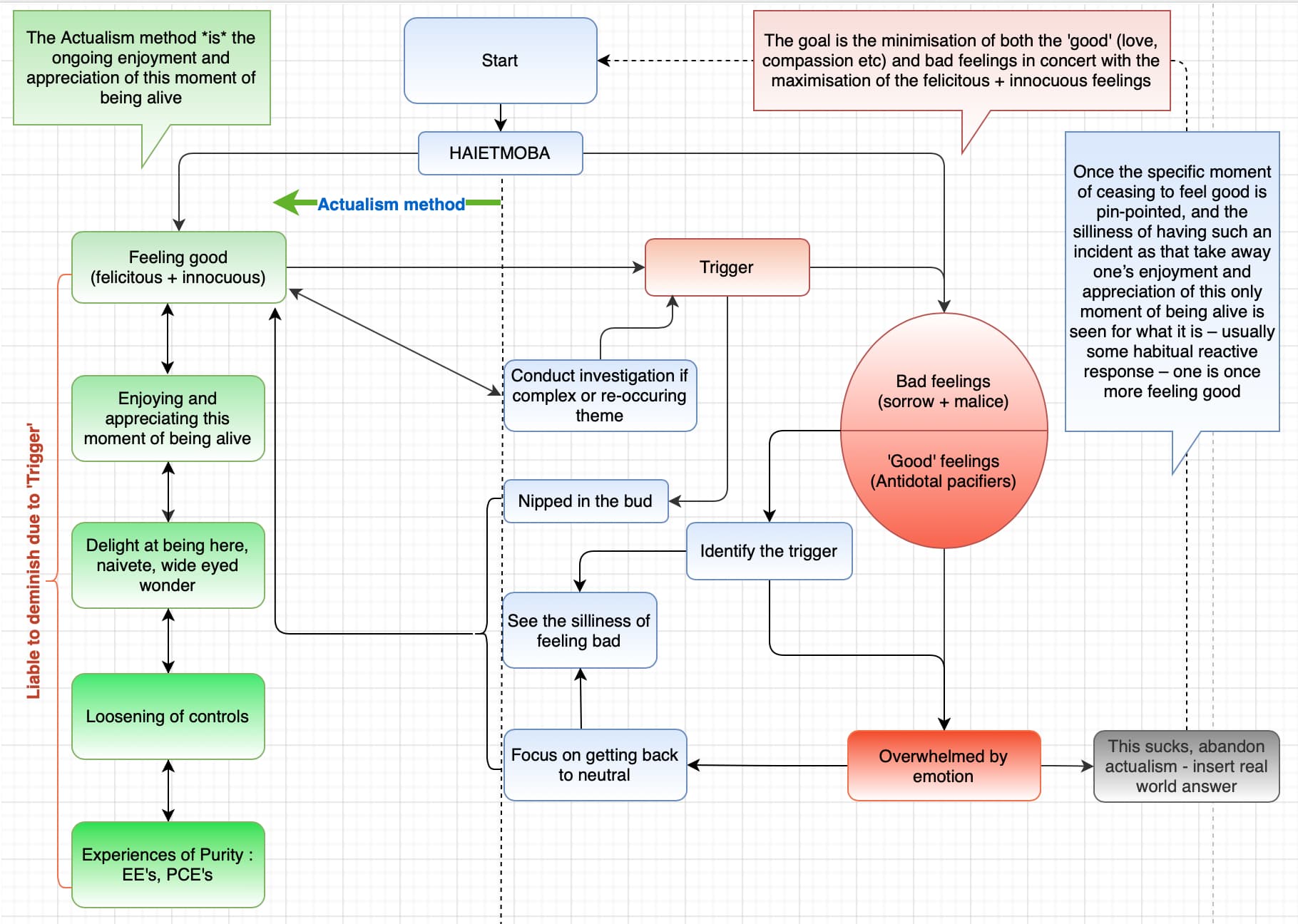
This is the second, slightly more complex one :
-
There is still the blue text box
-
I have added the ‘identify trigger box’ which either links into ‘see silliness’ or if one is unable to see the silliness it goes back into ‘overwhelmed’, this then gives one the option of moving into ‘neutral’ and as before there is also the option of taking the extra step from ‘neutral’ to ‘seeing the silliness’.
The problem with this diagram and the next one is that there is not an option for when one is unable to locate the trigger, but as a generalisation this can come under ‘overwhelmed’.
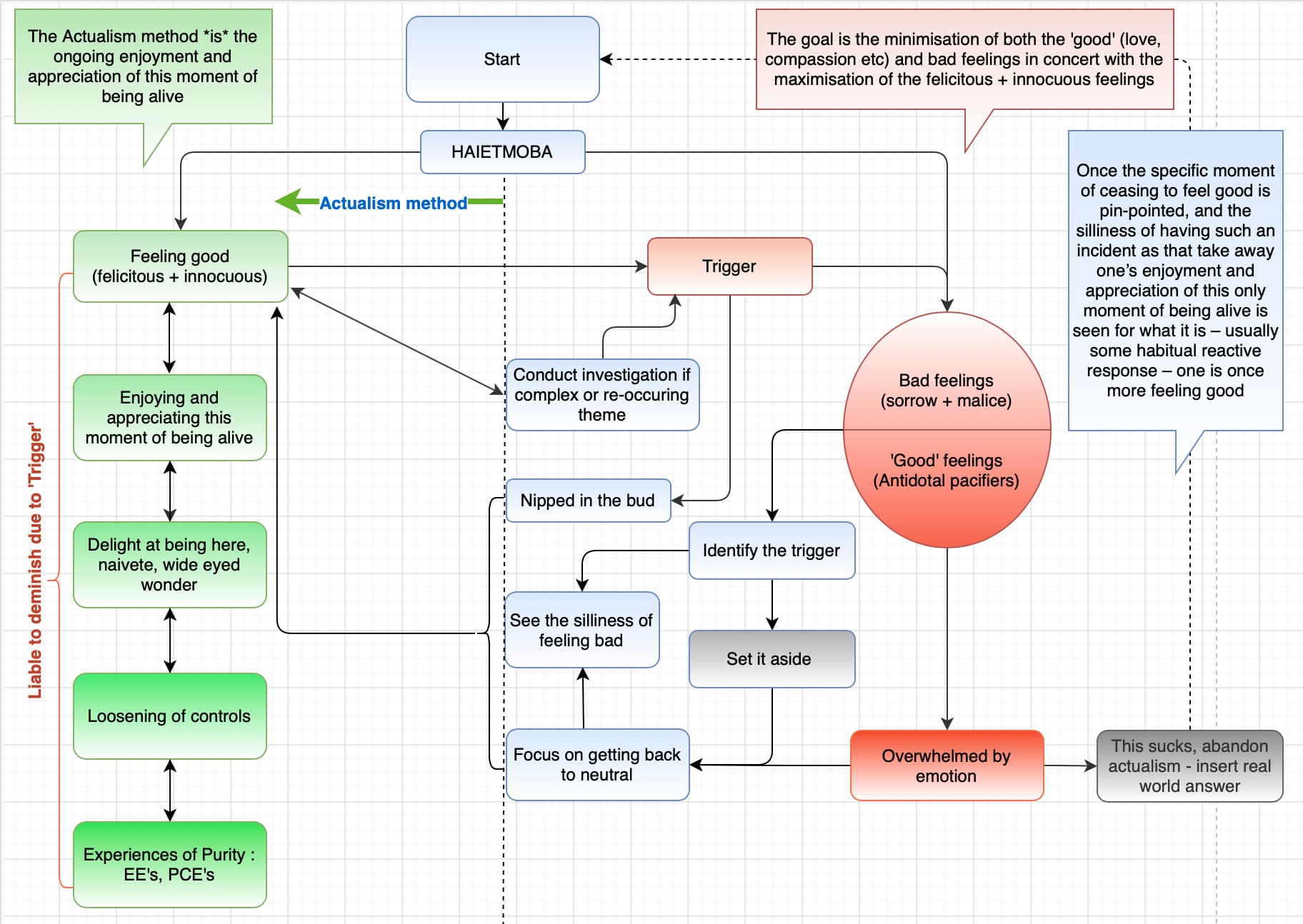
3rd and last, also possibly the most complex one :
-
So blue text added as before
-
‘Identify trigger’ also added but this time if one is unable to move to ‘see the silliness’, one can ‘set the trigger aside’ and proceed to move into feeling neutral, from there one has the option of revisiting the trigger and moving to ‘see the silliness’.
-
Again the issue with this is that not being able to spot the trigger is not addressed but I guess this can once more as a generalisation go through the ‘overwhelmed’ box.
- Diagram 1 is the most useful/effective one
- Diagram 2 is the most useful/effective one
- Diagram 3 is the most useful/effective one
- You’ve gone too far, scrap all and start again

0 voters
Also I think it is roughly around this point where it starts to become clear that this will never be an exact formula, we could prod and add more details until this resembles some elaborate quantum physics formula and still there would be variability to how it is used by each and every person.
I think ultimately with this diagram it is not how ‘right’ it is in some grand sense but how useful it is to an individual who is attempting to make sense of the method, I think this should be the primary criteria for assessing it.
Yea with that in mind I like #1 ![]()
I may have some free time over the next weeks, and see if I can try for the interactive web version. I think it could contain more complexity hidden by the fact that it only will show one step at a time. Will see if it takes shape …
I think for someone more new to actualism #3 is more descriptive and helpful xx
Yes, I tried to put myself in the novice’s shoes and I also think that 3 is clearer, BUT I consider any of the others a breakthrough in communicating AF more effectively.
And there will always be time to keep changing any of them, so… ![]()
OK great so I guess 3 is the winner ![]()
The one thing which I am finding bothersome with 3 is the following path :
One is feeling bad - one cannot identify trigger and ends up moving to ‘overwhelmed’ - from there one moves to ‘focus on getting back to neutral’
Once in neutral it appears that one has 2 options (whereas technically there is only 1) . Option 1 - to move into feeling good or option 2 - to ‘see the silliness’. However one has missed the trigger to begin with so one cannot move to ‘see the silliness’ step, unless he was to go through ‘identify the trigger’ first and I am not really wanting to add any more steps or complexity at this point.
But again I wonder whether this is just one of those things that is best to leave to everyone to suss out for themselves and realise that if they do take this path that in practice they would have to ‘identify the trigger’ before they can move from ‘neutral’ to ‘silliness’, I guess it does say that in the blue box!
(I just noticed that I have been writing sillyness instead of silliness).
I confess that in order not to complicate things, I have been holding back a point that may simplify (or complicate more ![]() ) things for you now.
) things for you now.
As far as I had seen in Richard’s writings before this diagram, he most commonly referred to seeing or feeling the silliness of feeling bad, the silliness of having happiness/unhappiness usurped, etc., not the silliness of the trigger.
What do you folks think/saw in AFT about this?
Yes well this is the very thing that I have been trying to clarify for myself. After reading @claudiu’s and @henryyyyyyyyyy’s recent posts I came to the conclusion that it is not feeling bad in itself that is seen as silly.
This is because as @henryyyyyyyyyy mentioned, when I am feeling bad there is a feeling that I am justified in feeling this way, without finding out what it is that I am feeling bad about I cannot sincerely see it as silly, I can only split myself in 2 with 1 part feeling like he is justified in feeling bad and the other trying to force feeling good.
What @claudiu wrote I think is also very on point, that finding the trigger is a necessary but not sufficient step. As in it is once the trigger is located that I have the opportunity to see the silliness of letting X take away from my enjoyment and appreciation, provided that the seeing is genuine and that ‘I’ am fully on board with this seeing.
Also reading the text in the blue box Richard states that "Once the specific moment of ceasing to feel good is pin-pointed (find the trigger step), and the silliness of having such an incident as that (no matter what it is) take away one’s enjoyment and appreciation of this only moment of being alive is seen for what it is (Seeing the silliness step) – usually some habitual reactive response – one is once more feeling good … but with a pin-pointed cue to watch out for next time so as to not have that trigger off yet another bout of the same-old same-old. (nipping in the bud step)
My understanding of the above is that it is specifically finding the trigger which sets the whole thing in motion. And I guess the silliness refers to both the trigger and having feeling good usurped. As in it is silly to let X take away feeling good. It is not just that the trigger is silly or that not feeling good is silly, but it is that having your happiness usurped by X is the silly thing!
What about this? ![]()
Ie identify the trigger can lead back to bad feelings or overwhelmed , as can trying to get back to neutral. At any point you can set it aside and back to start … and you can only see the silliness after identifying trigger.
I actually thought we were done iterating ![]() but it seems people are finding it helpful. I think it’s worth having as accurate a thing as possible, while keeping it as simple as possible… it’s not easy or trivial. but based on the feedback seems worth it
but it seems people are finding it helpful. I think it’s worth having as accurate a thing as possible, while keeping it as simple as possible… it’s not easy or trivial. but based on the feedback seems worth it ![]()
Yes @claudiu I fully agree it’s not trivial at all, my own practice since this thread has been supercharged haha! it’s been mega useful for me so far. When I have a chance later I will send a link to the website I am using as well as the most recent diagram version. This will allow everyone to have a play with re-arranging it in better and more concise ways.
Maybe once I have had a little break from the amendments I will do more too, I was only saying to @Sonyaxx last night that I am done and hanging up my gloves for any more changes, but looks like there might be more ![]()
![]()
No escape now ![]()
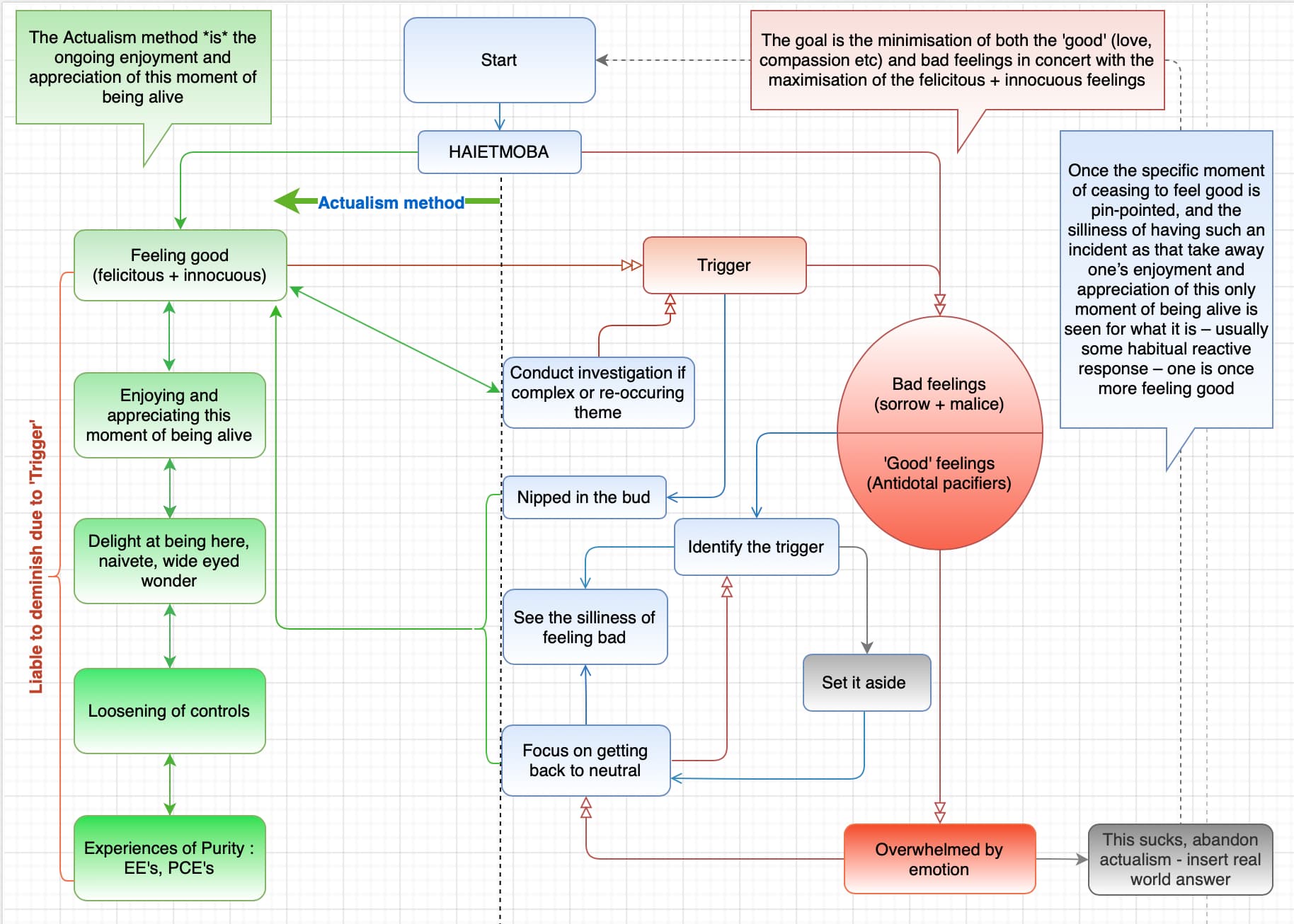
Ok so I am starting to go down a slightly different avenue with this, I thought instead of making it look more complex, to try to instead simplify by using visual aids.
So I have reshuffled the pathways in such a way that now one can miss the trigger → go into ‘overwhelmed’ → neutral and from there they now have a clear option to ‘identify the trigger’ and then proceed into ‘see the silliness’ and eventually ‘feeling good’.
The other main change I have done is categorising the arrows themselves to represent the typical pathways one may follow :
-
The green arrows represent the Plan A, (the ideal scenario) - they are the pathway where one continues feeling good and climbing up the felicitous ladder.
-
The blue arrows show the successful application of the tools in order to get back to feeling good - they are not the ideal scenario, after all one only applies the tools when one has wondered off the way, however they are still the ‘preferred’ option over the red arrows.
-
The red arrows show primarily the disruption to the application of the method by various feeling factors. One is best served to avoid following those paths however they will inevitably happened and one learns how to navigate out of them quickly and efficiently.
-
The grey arrows are more for things that aren’t really tools but more like a ‘break from trying’, until one is ready to feel good (green), apply the tools (blue) or face the gauntlet again
 (red)
(red)
This is just an idea for now but I think this could be useful in adding more specific options whilst still keeping simplicity.
All this after I said no more updates ![]()
Very good!
I think this was YOUR trigger to get to this update:
![]()
Yeah I think the colour thing worked out pretty nice, I might also include a legend somewhere on there so it summarises the green, blue, red, grey idea, sorta like I did above.
Btw if anyone wants to make any amendments themselves the website I have been using is - Flowchart Maker & Online Diagram Software
I have the latest versions of the chart saved as a file which opens on that website but I am not able to attach it here for some reason I think the file type is not supported. It is a ‘drawio’ file.
Oo cool I might wanna give it a try. Hmm thinking how you could share it easily … can you email me? actualist.claudiu@gmail.com
That being said I love the new version with color coded arrows.
